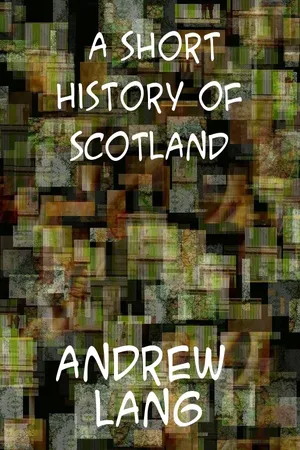
- 315 pages
- English
- ePUB (mobile friendly)
- Available on iOS & Android
About This Book
pubOne.info thank you for your continued support and wish to present you this new edition. If we could see in a magic mirror the country now called Scotland as it was when the Romans under Agricola (81 A.D.) crossed the Border, we should recognise little but the familiar hills and mountains. The rivers, in the plains, overflowed their present banks; dense forests of oak and pine, haunted by great red deer, elks, and boars, covered land that has long been arable. There were lakes and lagoons where for centuries there have been fields of corn. On the oldest sites of our towns were groups of huts made of clay and wattle, and dominated, perhaps, by the large stockaded house of the tribal prince. In the lochs, natural islands, or artificial islets made of piles (crannogs), afforded standing-ground and protection to villages, if indeed these lake- dwellings are earlier in Scotland than the age of war that followed the withdrawal of the Romans.
Frequently asked questions
Information
Table of contents
- CHAPTER I. SCOTLAND AND THE ROMANS.
- CHAPTER II. CHRISTIANITY - THE RIVAL KINGDOMS.
- CHAPTER III. EARLY WARS OF RACES.
- CHAPTER IV. MALCOLM CANMORE - NORMAN CONQUEST.
- CHAPTER V. DAVID I. AND HIS TIMES.
- CHAPTER VI. MALCOLM THE MAIDEN.
- CHAPTER VII. ENCROACHMENTS OF EDWARD I. - WALLACE.
- CHAPTER VIII. BRUCE AND THE WAR OF INDEPENDENCE.
- CHAPTER IX. DECADENCE AND DISASTERS - REIGN OF DAVID II.
- CHAPTER X. EARLY STEWART KINGS: ROBERT II. (1371-1390).
- CHAPTER XI. JAMES I.
- CHAPTER XII. JAMES II.
- CHAPTER XIII. JAMES III.
- CHAPTER XIV. JAMES IV.
- CHAPTER XV. JAMES V. AND THE REFORMATION.
- CHAPTER XVI. THE MINORITY OF MARY STUART.
- CHAPTER XVII. REGENCY OF ARRAN.
- CHAPTER XVIII. REGENCY OF MARY OF GUISE.
- CHAPTER XIX. THE GREAT PILLAGE.
- CHAPTER XX. MARY IN SCOTLAND.
- CHAPTER XXI. MINORITY OF JAMES VI.
- CHAPTER XXII. REIGN OF JAMES VI.
- CHAPTER XXIII. THE GOWRIE CONSPIRACY.
- CHAPTER XXIV. CHARLES I.
- CHAPTER XXV. CONQUERED SCOTLAND.
- CHAPTER XXVI. THE RESTORATION.
- CHAPTER XXVII. WILLIAM AND MARY.
- CHAPTER XXVIII. DARIEN.
- CHAPTER XXIX. PRELIMINARIES TO THE UNION.
- CHAPTER XXX. GEORGE I.
- CHAPTER XXXI. THE ARGATHELIANS AND THE SQUADRONE.
- CHAPTER XXXII. THE FIRST SECESSION.
- CHAPTER XXXIII. THE LAST JACOBITE RISING.
- CONCLUSION.
- FOOTNOTES
- Copyright